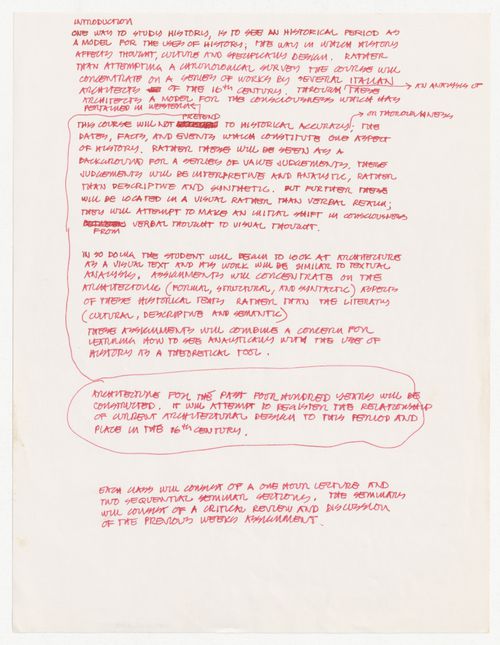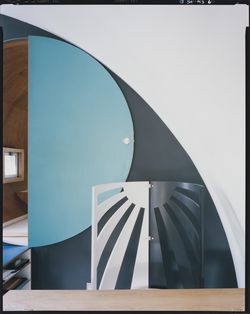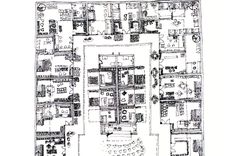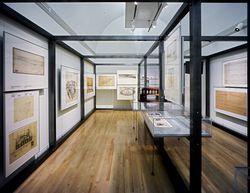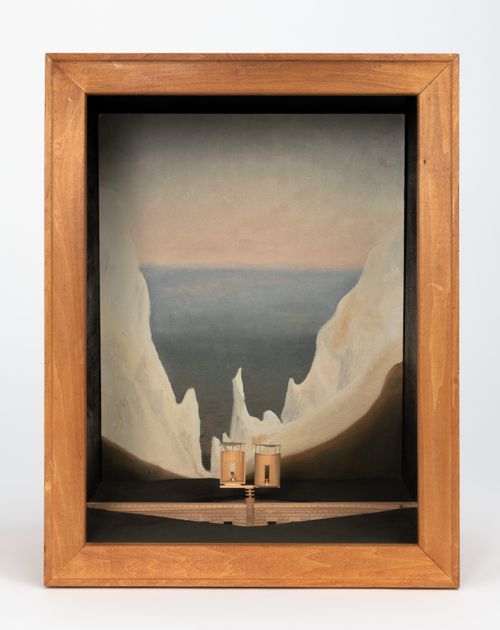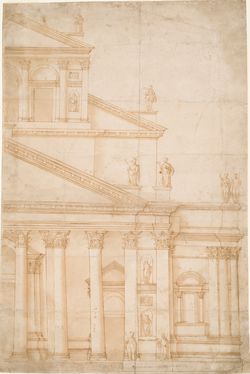AP140.S2.SS1.D26.P31.1
Description:
model shows the History Faculty Building, and interior elements including the library mezzanine and the galleries and escape stairs of the L-shaped block
1963 - 1967
Presentation model for the History Faculty Building, University of Cambridge, displayed in the exhibition Architecture I (1977) at Leo Castelli Gallery
Actions:
AP140.S2.SS1.D26.P31.1
Description:
model shows the History Faculty Building, and interior elements including the library mezzanine and the galleries and escape stairs of the L-shaped block
maquettes
AP140.S2.SS1.D26.P31
Description:
model shows the History Faculty Building, and interior elements including the library mezzanine and the galleries and escape stairs of the L-shaped block
1963 - 1967
Presentation model for the History Faculty Building, University of Cambridge, displayed in the exhibition Architecture I (1977) at Leo Castelli Gallery
Actions:
AP140.S2.SS1.D26.P31
Description:
model shows the History Faculty Building, and interior elements including the library mezzanine and the galleries and escape stairs of the L-shaped block
maquettes
1963 - 1967
ARCH401375
1980-1982
Figure ayant profondément marqué l’architecture d’après-guerre au Japon, Kazuo Shinohara s’est surtout fait connaître pour ses maisons individuelles. Or il reste peu étudié de nos jours, particulièrement à l’extérieur du Japon. Il a joint certaines formes traditionnelles et l’exploration de principes modernistes au moment des technologies de pointe et de l’information(...)
21 septembre 2017, 18h30
David B. Stewart, quel sens avait l’histoire pour Kazuo Shinohara?
Actions:
Description:
Figure ayant profondément marqué l’architecture d’après-guerre au Japon, Kazuo Shinohara s’est surtout fait connaître pour ses maisons individuelles. Or il reste peu étudié de nos jours, particulièrement à l’extérieur du Japon. Il a joint certaines formes traditionnelles et l’exploration de principes modernistes au moment des technologies de pointe et de l’information(...)
articles
Architectures des soins
De La Migration
30 août 2021
De La Migration
dessins
DR1976:0009
Description:
- Drawings DR1976:0008 and DR1976:0009 show a project for a rotunda designed by Legrand and Molinos for the amphitheatre for the Museum of Natural History, Paris. The final design for a square building with three semi-circular rotundas, was built by Legrand and Molinos in the Jardin des Plantes, Paris (1791). These drawings were once part of an album of Legrand architectural designs.
1792 ?
Section for an amphitheatre for the Museum of Natural History, Paris
Actions:
DR1976:0009
Description:
- Drawings DR1976:0008 and DR1976:0009 show a project for a rotunda designed by Legrand and Molinos for the amphitheatre for the Museum of Natural History, Paris. The final design for a square building with three semi-circular rotundas, was built by Legrand and Molinos in the Jardin des Plantes, Paris (1791). These drawings were once part of an album of Legrand architectural designs.
dessins
1792 ?
L’exposition Lidée de la grande ville s’intéresse au rôle de l’urbanisme dans tout l’Empire austro-hongrois, avant et après sa dissolution, et enrichit l’histoire de l’architecture en mettant en évidence la diversité des tendances modernistes de cette période. Autour de la Première Guerre mondiale, cette diversité était le reflet des nombreuses identités nationales et(...)
Salles principales et vitrines
14 mai 2000 au 15 octobre 2000
L'idée de la grande ville : l'architecture moderne en Europe centrale, 1890–1937
Actions:
Description:
L’exposition Lidée de la grande ville s’intéresse au rôle de l’urbanisme dans tout l’Empire austro-hongrois, avant et après sa dissolution, et enrichit l’histoire de l’architecture en mettant en évidence la diversité des tendances modernistes de cette période. Autour de la Première Guerre mondiale, cette diversité était le reflet des nombreuses identités nationales et(...)
Salles principales et vitrines
DR2019:0013
Description:
Model for one of four "Folly" projects designed by Agrest and Gandelsonas for the exhibition "Architecture III: Follies: Architecture for the Late Twentieth-Century Landscape" at Leo Castelli Gallery, New York, October 22-November 19, 1983
1983?
Model for Folly Three: The Rigorous Abolition of History
Actions:
DR2019:0013
Description:
Model for one of four "Folly" projects designed by Agrest and Gandelsonas for the exhibition "Architecture III: Follies: Architecture for the Late Twentieth-Century Landscape" at Leo Castelli Gallery, New York, October 22-November 19, 1983
dessins
DR1976:0008
Description:
- Drawings DR1976:0008 and DR1976:0009 show a project for a rotunda designed by Legrand and Molinos for the amphitheatre for the Museum of Natural History, Paris. The final design for a square building with three semi-circular rotundas, was built by Legrand and Molinos in the Jardin des Plantes, Paris (1791). These drawings were once part of an album of Legrand architectural designs.
1792 ?
Principal elevation for an amphitheatre for the Museum of Natural History, Paris
Actions:
DR1976:0008
Description:
- Drawings DR1976:0008 and DR1976:0009 show a project for a rotunda designed by Legrand and Molinos for the amphitheatre for the Museum of Natural History, Paris. The final design for a square building with three semi-circular rotundas, was built by Legrand and Molinos in the Jardin des Plantes, Paris (1791). These drawings were once part of an album of Legrand architectural designs.
dessins
1792 ?
L’histoire de l’architecture traite des relations entre espace, bâtiment, géométrie urbaine et pratiques sociales – elle exprime comment l’expérience de l’espace correspond à une expérience du monde. Cette conférence présentera une analyse du débat qui, au XVIe siècle, a entouré l’achèvement de la façade de la basilique San Petronio à Bologne, construite en partie dans un(...)
Théâtre Paul-Desmarais Mot(s)-clé(s):
Guido Beltramini, basilique San Petronio, Bologne, Andrea Palladio, Baldassare Peruzzi, Giacomo da Vignola
5 octobre 2017, 18h30
Guido Beltramini, quel sens avait l’histoire pour les architectes et leurs mécènes à Bologne, en 1579?
Actions:
Description:
L’histoire de l’architecture traite des relations entre espace, bâtiment, géométrie urbaine et pratiques sociales – elle exprime comment l’expérience de l’espace correspond à une expérience du monde. Cette conférence présentera une analyse du débat qui, au XVIe siècle, a entouré l’achèvement de la façade de la basilique San Petronio à Bologne, construite en partie dans un(...)
Théâtre Paul-Desmarais Mot(s)-clé(s):
Guido Beltramini, basilique San Petronio, Bologne, Andrea Palladio, Baldassare Peruzzi, Giacomo da Vignola

